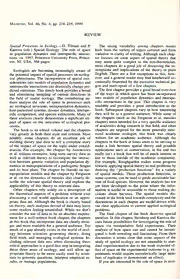
Spatial Processes in Ecology by D. Tilman, P. Kareiva PDF
Preview Spatial Processes in Ecology by D. Tilman, P. Kareiva
Madrono, Vol. 46, No. 4, pp. 218-219, 1999 REVIEW — Spatial Processes in Ecology. D. Tilman and P. The strong variability among chapters results Kareiva (eds.) Spatial Ecology: The role of space both from the variety of topics covered and from in population dynamics and interspecific interac- variation in clarity ofwriting. Although each chap- tions, ca. 1997, Princeton University Press, Prince- ter focuses on some aspect of spatial theory that ton, NJ, USA, 368 pages. may seem quite complex to the non-theoretician, most chapters do a good job of discussing the as- Ecologists are becoming increasingly aware of sumptions and implications of the theory in plain the potential impact ofspatial processes on ecolog- English. There are a few exceptions to this, how- ical phenomena. The incorporation of spatial con- ever, and a general reader may find him/herselfoc- siderations into models ofpopulation dynamics and casionally frustrated by the excessive technicaljar- interspecific interactions candrastically changepre- gon and math-speak of a few chapters. dicted outcomes. This timelybookprovides abroad The firstchapterprovides agoodbroad overview and stimulating sampling of current directions in of the ways in which space has been incorporated the field of spatial ecology. The contributing au- into models of population dynamics and interspe- thors analyze the role of space in processes such cific interactions in the past. This chapter is very as: ecological invasions, metapopulation dynamics, readable and provides a great introduction to the host-parasitoid systems, diseasedynamics, interspe- book. Subsequent chapters vary in how interesting cific competition, and species extinctions. Many of they will be to a general audience. While some of these analyses clearly demonstrate a significant im- the chapters (such as the Ferguson et al. measles pact of space on the outcomes of ecological pro- chapter) seem intended for a very specific audience cesses. ofacademics doing research in that field, and other The book is an edited volume and the chapters chapters are targeted for the more generally inter- vary greatly in both their style and content. Most ested academic ecologist, this book was clearly notably, some chapters do an excellent job of written for an academic audience. Although the melding theory and data to tell a complete story chapters in the book at times seem to be striving to of the impact of space on the topic under consid- make a link between spatial theory and possible eration. For example, the chapter by Antonovics applications such as conservation, in the end this et al. utilizes extensive, long-term survey data as really isn't a book that will be of much interest or well as relevant theory to investigate the interac- use to those outside of the academic community. tion between genetic variation and population dy- For example, Roughgarden makes some progress namics in metapopulations ofa pathogenic fungus towards applying spatial theory to real problems by and its host plant. The chapter by Hanski on me- deriving the "production functions" for a variety tapopulation models and the chapter by Ferguson of spatial models. These production functions, in et al. on the dynamics of measles also clearly de- some systems, canbe used to guide sustainablehar- scribe the relevant spatial theory and explore the vest offood species. However, the analysis has not applicability of this theory to relevant data. yet been developed to the point where the infor- Other chapters rely solely on a description of mation is useful or accessible to those making de- the theoretical aspects of a problem without ever cisions about harvests. The spatial models dis- discussing a real world application or an appro- cussedin thebooktend towards complexity andthe priate data set. Although the book is clearly based discussions in each chapter are model-driven with- on theory, such analyses devoid ofdata may leave out clear applications to current applied ecological some readers feeling unsatisfied. While we don't problems. consider the use ofdata to be an absolute require- The final chapter of the book deserves special ment for a well-written book chapter, the chapters mention. In this chapter, Steinberg and Kareivadis- in this book that incorporate data are clearly stron- cuss future possibilities for investigating the role of ger and more readable for a general audience. Too space via manipulative field experiments. Their much of a gap already exists in the world ofecol- analysis of how space can and cannot be investi- ogy between scientists generating theory, doing gated is both revealing and fascinating. From their field work, and managing ecological systems. In- discussion it seems clear that some aspects of the cluding relevant data sets when discussing theo- study of spatial ecology are not amenable to stan- retical approaches is agood first step in integrating dard experimentation due to the weak expected ef- these three areas of ecology, and will allow ap- fect ofspace on the experimental outcome (e.g. ex- propriate theory to be more easily used by scien- periments would require unrealistically large num- tists to generate questions, interpret empirical re- bers of replicates to demonstrate an effect). sults, or manage populations. Ifyou are interested in the role of space in ecol- 1999] REVIEW 219 ogy and in understanding current thinking on how dangered species expert, looking for some guide- space may affect ecological phenomena, then this lines on how to deal with the spatial aspects ofyour is the bookforyou. The list ofauthors is impressive system, you probably need to look elsewhere. and their expertise is clear. The book is also quite — comprehensive, as we mentioned above, and will Christy A. Brigham and Jason D. Hoeksema. serve as a good summary of the role of space in Department of Environmental Science and Policy, Uni- ecology. If you are a resource manager or an en- versity ofCalifornia-Davis.
